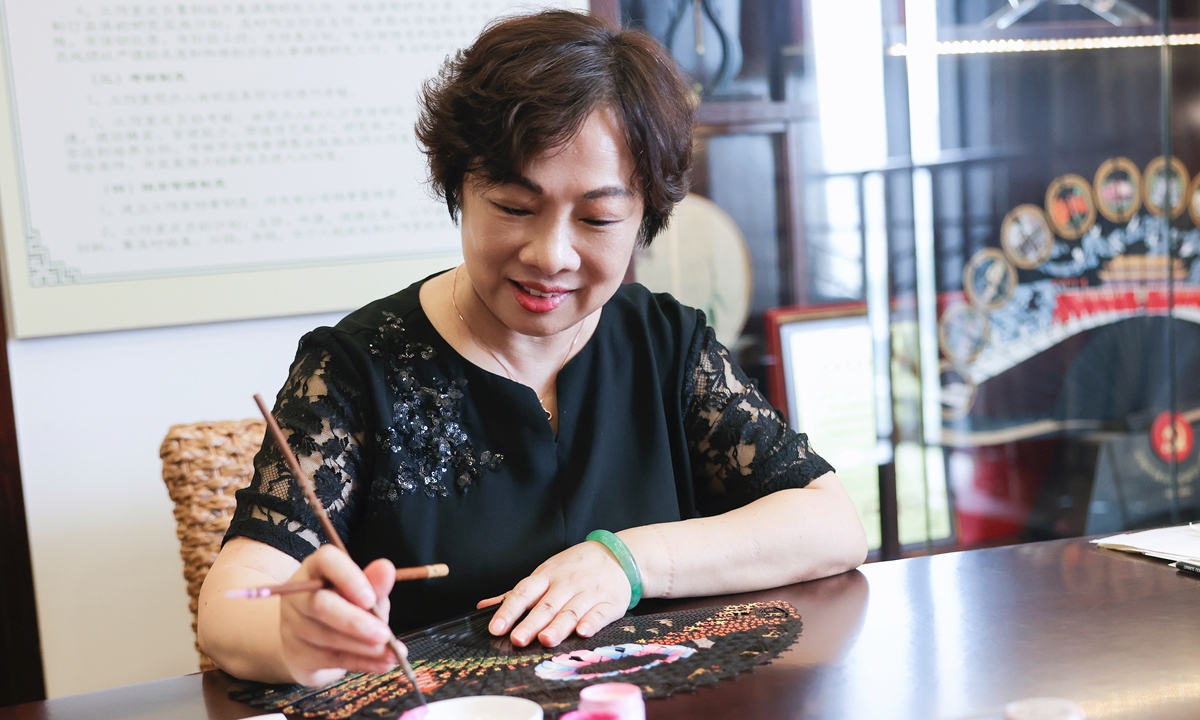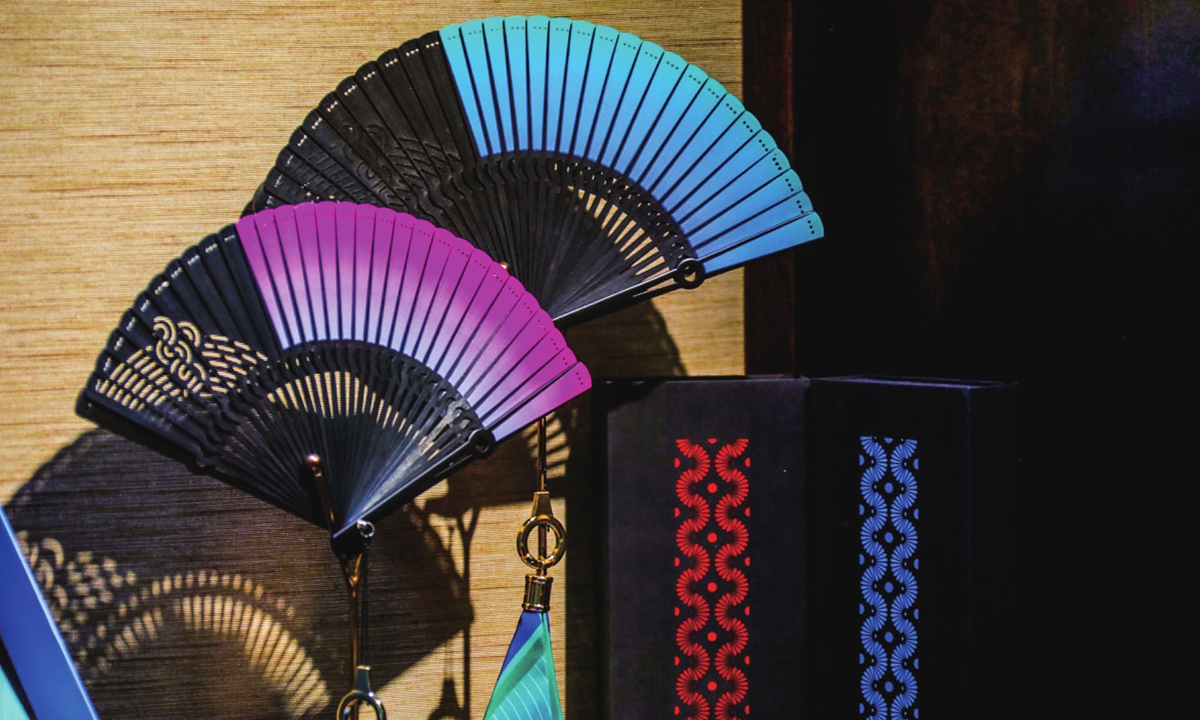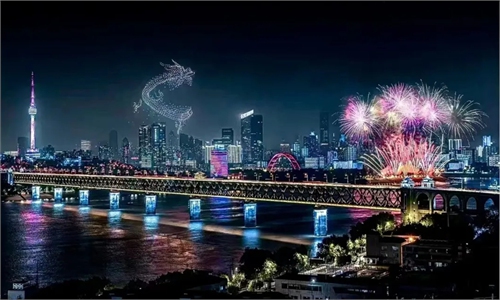ARTS / CULTURE & LEISURE
Wangxingji fan-making techniques show the zing of ICH
Handmade legacy
Editor's Note:
From exquisite craftsmanship to traditional medicine, and from solemn rituals to vibrant folk art, intangible cultural heritages weave a rich tapestry of Chinese identity, decorating the various facets of contemporary Chinese people's lives.
In this series, the Global Times culture desk will walk readers through China's most renowned traditions. For centuries, the essential elements of Chinese intangible cultural heritage have been passed down from master to apprentice, from generation to generation. Today, the ancestral wisdom is being reinvigorated by a new generation of inheritors with creativity.

This fan is a "national gift" presented by the fan-making brand Wangxingji at the 19th Asian Games in Hangzhou. At a national banquet prior to the event, a demonstration of the making of Wangxingji's fans was held in front of numerous international guests and foreign heads of state, who expressed great appreciation for the art. Produced through 86 handcrafting processes, the "black paper fan" is also the most iconic product of Wangxingji, an Intangible Cultural Heritage (ICH) brand that has showcased China's fan-making artistry since the Qing Dynasty (1644-1911).
Unlike many other fan products, the water-resistant black fans decorated with Chinese poetry inscriptions represent the wisdom of Chinese craftsmanship and literati spirits while exhibiting a demure aesthetic taste. Traditional Wangxingji black fans are an optimal way for the public to engage with the 150-year-old local history and appreciate the continuous integration of modern elements in its designs.
Benchmark for ancient fans
Fans made of materials such as sandalwood and silk are part of Wangxingji's diverse products. Nowadays, the company has created 19 different kinds of fans and more than 10,000 types of decorative fan patterns. "Every single one of our products is still handmade," revealed the company's director Sun Yaqing, adding that their "handcrafted tradition in the mechanized age" is what has made their ICH legacy most valuable.
Sun is not only the brand's leader, but also the ICH inheritor of a fan-making technique called "la hua." It refers to using thin steel wires to carve intricate patterns on fans. Wangxingji's fan-making techniques are a time-honored tradition dating back to 1875, when the brand was first established in Hangzhou, East China's Zhejiang Province.
Around that time, Wang Xingzhai, the founder of the brand, created a "color painted black fan" with his wife. The piece was unique and set a clear benchmark for ancient Chinese fan-making industry.
"The whole black fan was evenly covered with a sort of glittery paint made from gold. The paint's nuanced color differences were the result of the gold's different degrees of purity. The fan's skeleton was decorated with colorful snail shells too," Wang Siyi, the deputy manager of the cultural and creative department of Wangxingji, told the Global Times.
In ancient time, artifacts such as Wangxingji's finely made fans were often given by the Chinese royals as gift to overseas guests. Liu Jiao, an insider of the Chinese arts and crafts history, told the Global Times that although it is small, a Chinese fan can "embody the country's aesthetic spirit and cultural narratives."
Wangxingji's fans often showcase visual imagery inspired by traditional Taoist philosophy. One striking example is a black fan featuring the literary classic "Four Books and Five Classics." This fan boasts an astonishing aesthetic, featuring the text inscribed in 120,000 Chinese characters, each measuring just one millimeter. "Nowadays, fans are not only a useful everyday tool. They are cultural objects that display one's aesthetic and invite people overseas to notice the depth and diversity of Chinese folk culture," Sun told the Global Times.

The success of Wangxingji on the global stage has not slowed down its momentum. It has always been Sun's motto that "If the fan does not connect with people, then it is not an ICH legacy." This philosophy drives her to explore innovative ways to keep the Wangxingji fan relevant and "in-trend."
In 2010, Wangxingji established a cultural and creative park that includes facilities like a museum, workshops and also a section dedicated to cross-field cultural products. A notable example of their innovation came during the 19th Asian Games Hangzhou, during which Wangxingji launched a fan collection by collaborating with the event organizers.
Wang Suxian, the manager of the cultural and creative department of Wangxingji, told the Global Times that such presentations are aimed to attract young consumers. In order to promote the brand, the Wangxingji team has also tried to expand its scope of creative design sharing both online and in people daily lives.
From exquisite craftsmanship to traditional medicine, and from solemn rituals to vibrant folk art, intangible cultural heritages weave a rich tapestry of Chinese identity, decorating the various facets of contemporary Chinese people's lives.
In this series, the Global Times culture desk will walk readers through China's most renowned traditions. For centuries, the essential elements of Chinese intangible cultural heritage have been passed down from master to apprentice, from generation to generation. Today, the ancestral wisdom is being reinvigorated by a new generation of inheritors with creativity.

Sun Yaqing, the director and intangible cultural heritage inheritor of Wangxingji Photo: Courtesy of Wangxingji
On the surface of a brown-black ebony fan, numerous patterns of golden osmanthus flowers and an ancient pagoda were intricately carved, showcasing the fan's unique Chinese aesthetics.This fan is a "national gift" presented by the fan-making brand Wangxingji at the 19th Asian Games in Hangzhou. At a national banquet prior to the event, a demonstration of the making of Wangxingji's fans was held in front of numerous international guests and foreign heads of state, who expressed great appreciation for the art. Produced through 86 handcrafting processes, the "black paper fan" is also the most iconic product of Wangxingji, an Intangible Cultural Heritage (ICH) brand that has showcased China's fan-making artistry since the Qing Dynasty (1644-1911).
Unlike many other fan products, the water-resistant black fans decorated with Chinese poetry inscriptions represent the wisdom of Chinese craftsmanship and literati spirits while exhibiting a demure aesthetic taste. Traditional Wangxingji black fans are an optimal way for the public to engage with the 150-year-old local history and appreciate the continuous integration of modern elements in its designs.
Benchmark for ancient fans
Fans made of materials such as sandalwood and silk are part of Wangxingji's diverse products. Nowadays, the company has created 19 different kinds of fans and more than 10,000 types of decorative fan patterns. "Every single one of our products is still handmade," revealed the company's director Sun Yaqing, adding that their "handcrafted tradition in the mechanized age" is what has made their ICH legacy most valuable.
Sun is not only the brand's leader, but also the ICH inheritor of a fan-making technique called "la hua." It refers to using thin steel wires to carve intricate patterns on fans. Wangxingji's fan-making techniques are a time-honored tradition dating back to 1875, when the brand was first established in Hangzhou, East China's Zhejiang Province.
Around that time, Wang Xingzhai, the founder of the brand, created a "color painted black fan" with his wife. The piece was unique and set a clear benchmark for ancient Chinese fan-making industry.
"The whole black fan was evenly covered with a sort of glittery paint made from gold. The paint's nuanced color differences were the result of the gold's different degrees of purity. The fan's skeleton was decorated with colorful snail shells too," Wang Siyi, the deputy manager of the cultural and creative department of Wangxingji, told the Global Times.
In ancient time, artifacts such as Wangxingji's finely made fans were often given by the Chinese royals as gift to overseas guests. Liu Jiao, an insider of the Chinese arts and crafts history, told the Global Times that although it is small, a Chinese fan can "embody the country's aesthetic spirit and cultural narratives."
Wangxingji's fans often showcase visual imagery inspired by traditional Taoist philosophy. One striking example is a black fan featuring the literary classic "Four Books and Five Classics." This fan boasts an astonishing aesthetic, featuring the text inscribed in 120,000 Chinese characters, each measuring just one millimeter. "Nowadays, fans are not only a useful everyday tool. They are cultural objects that display one's aesthetic and invite people overseas to notice the depth and diversity of Chinese folk culture," Sun told the Global Times.

Representative fans by Wangxingji
Keeping up with timesThe success of Wangxingji on the global stage has not slowed down its momentum. It has always been Sun's motto that "If the fan does not connect with people, then it is not an ICH legacy." This philosophy drives her to explore innovative ways to keep the Wangxingji fan relevant and "in-trend."
In 2010, Wangxingji established a cultural and creative park that includes facilities like a museum, workshops and also a section dedicated to cross-field cultural products. A notable example of their innovation came during the 19th Asian Games Hangzhou, during which Wangxingji launched a fan collection by collaborating with the event organizers.
Wang Suxian, the manager of the cultural and creative department of Wangxingji, told the Global Times that such presentations are aimed to attract young consumers. In order to promote the brand, the Wangxingji team has also tried to expand its scope of creative design sharing both online and in people daily lives.



